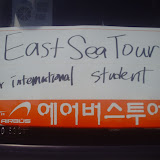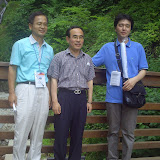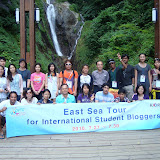 Ulleungdo is a pentagon-shaped island located 92km away from Dokdo Islet.
Ulleungdo is a pentagon-shaped island located 92km away from Dokdo Islet.The island was made from a series of volcanic eruptions. Its highest peak is called Seonginbong Peak, and there is a village along the coastline on the slope. On the north side is a caldera crater which collapsed to create the Nari Basin and the Albong Basin.
Level ground is difficult to find here and the shores are mostly cliffs. There are a lot of snow in the winter. About half of the people work in the fishing industry. Corn, potatoes, wheat and beans were cultivated here, but nowadays mountain plants and medicinal herbs are mostly grown instead.
There are dongbaek trees and some 650 other plants and trees thriving on the island. The neighboring waters is the junction line between two cold & warm ocean currents, where many squids, saury and pollacks are caught. The Ulleungdo squid is especially famous for their outstanding quality. It has been said that there are no thieves, pollution or snakes on Ulleungdo Island. On the other hand, there are many aromatic trees, wind, beautiful women, water and rocks. This is why it is called the island of The Three Mu (The Chinese character meaning ' have nothing') and Five Da (The Chinese character meaning 'have many of').
For more information http://www.ulleung.go.kr/English/
 Deodeok(Codonopsis lanceolata)*There is a mark of Ulleungdo squid in the Taenggitdae.
Deodeok(Codonopsis lanceolata)*There is a mark of Ulleungdo squid in the Taenggitdae.Squid dishes are squid mulhoi(sashimi soup), squid seasoned with vinegar and condiment, squid sundae, squid bulgogi, squid bowel soup and squid jeotgal(salted fish), and you can taste delicious squid dishes at a low price in raw fish restaurants in Ulleungdo, Jeodong fish market, Dodong wharf and etc.



 With Yun-yeol Jeong,Mayor of Ulleung County... http://www.ulleung.go.kr/English/about/about_sub01.htm?mnu_siteid=eng&mnu_uid=577
With Yun-yeol Jeong,Mayor of Ulleung County... http://www.ulleung.go.kr/English/about/about_sub01.htm?mnu_siteid=eng&mnu_uid=577 Mushroom-like rock created by the volcanic island, Ulleungdo...
Mushroom-like rock created by the volcanic island, Ulleungdo... Taking pictures with YB rock(KoreaRock)
Taking pictures with YB rock(KoreaRock) Around Dokdo Island
Around Dokdo Island With Assistant Minister Seo Kang-soo of the Korea Culture and Information Service...!!!
With Assistant Minister Seo Kang-soo of the Korea Culture and Information Service...!!!By the way,check below pictures and those pictures show how I enjoyed the scenery with WSK by taking a cruise around Ulleungdo, Gwaneumdo Islands, and a natural tunnel. Elephant Rock, Samseonan, and Lion Rock are some of the other tourist attractions praised by tourists.
"Dokdo Museum "
 |
| Dokdo Museum |
 |
| East Seat Tour, 1st Day |
 |
Ulleong-do and Dokdo Islands, 4th days |
 |
| Ulleung-do Island,3rd days |
 |
| East Seat Tour, 2nd Days |
That was a remarkable experience we had there during four days
Thank you PCNB and Thank you KOIS~









